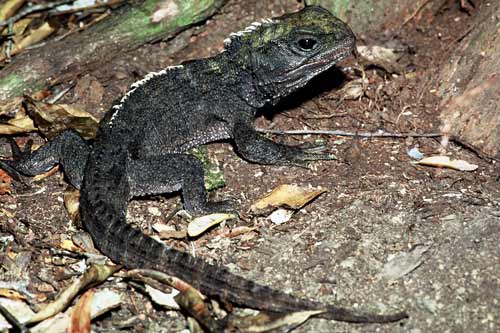
What? Were you expecting something more spectacular? That is a tuatara, which is, in itself, a whole new group of reptiles (order Sphenodontia). That makes it about as close to lizards as crocodiles and snakes. They're an old line of reptiles. A really old line.
Tuataras are not living fossils. Despite being of a distinctly ancient lineage, tuataras have changed a lot since the Mesozoic. They are, however, the most unspecialized living amniotes; they have hearts and brains like amphibians, only one chamber to their lungs (if you have ever taken a look inside the human body, you KNOW how significant that is), and move more like salamanders than lizards.
They also have surprisingly uniform skulls when compared to their fossil record. Unlike lizards, they do not have ears; they hear more like turtles than anything with external ear holes. Their spines are linked more like that of a fish than that of a reptile. Speaking of, the little spikes on their backs do look classy, don't they?
In other words, the tuatara is one of those things that looks like a duck, but does not quack like one or walk like one. Or have organs like one.

As if tuatara were not freaky enough, they have third eyes. You have a third eye, too, but it is not nearly as sophisticated as the tuatara's. I want you to do something very simple before I go on: Find you pineal gland.

(If you can't find that but know where the third eye chakra is, that's cool, too.)
Right there (relatively, of course), many reptiles have something called a parietal eye. In most species, the eye does very little besides detect light. In the tuatara, it has rods, cones, a retina and other structures your eye doctor probably told you about if you have ever gone in for an eye exam. It probably came from a real third eye. Of all the things to do with a third eye, the tuatara uses it to gather vitamin D from the sun.

I seeee you.
Fascinating though they may be, tuataras are vulnerable. Many of them were wiped out thanks to Polynesian rats. Get the image of a rat in a grass skirt out of your head; rats are a serious invasive species that tends to cause a ton of ecological damage if previously unestablished.
Alas, tuataras are nigh-on impossible to breed in captivity. One of the requirements for a species to be considered domesticable is a reasonable breeding period relative to humans - that is, a higher maturation and reproductive rate than people. The tuatara takes ten years to become sexually mature; they can breed well into their 60's and live over a hundred years. That's right, when humans are having trouble reproducing, the tuataras are having no problems at all. No Viagra necessary!

Sooo... why were *you* thinking about tuataras today?
ReplyDeleteI was reading about rhynchosaurs and sphenodonts in my new book and decided to google 'parietal eye'
I also got a new book and was also reading about sphenodonts. O.o;
ReplyDeleteI've been reading a Terry Pratchett book (a collaborative work however), the "Science of the Discworld", and the tuatara is referenced as one of the closest approximations in the current global ecosystem to the earliest reptiles found in the Carboniferous era - is was recommended to look at them to gain an idea of the locomotion, appearance and behavioural traits. And as you note, the tag 'living fossil' is incorectly applied often - while 200 million years old, they have still undergone much evolution within the order since this and later periods.
ReplyDeleteNice article though, good taster to get people looking into it a bit more :)